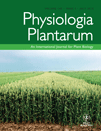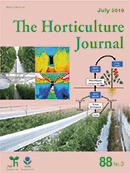
Horticulturae
Scope & Guideline
Nurturing Ideas, Harvesting Solutions.
Introduction
Aims and Scopes
- Plant Genetics and Genomics:
The journal publishes research on the genetic and genomic aspects of horticultural crops, including genome-wide association studies, gene expression analysis, and the identification of key genes related to traits such as fruit quality and stress tolerance. - Sustainable Horticultural Practices:
A significant focus is placed on sustainable agriculture, including the use of biostimulants, organic fertilizers, and innovative cultivation techniques that reduce environmental impact while enhancing crop yield and quality. - Physiological and Biochemical Responses to Stress:
Research articles explore how horticultural plants respond to various abiotic stresses (e.g., drought, salinity, temperature) and biotic stresses (e.g., pathogens), contributing to a better understanding of plant resilience and adaptation. - Postharvest Technology:
The journal addresses postharvest handling, storage, and quality preservation techniques for fruits and vegetables, including the use of coatings, modified atmosphere packaging, and treatments to extend shelf life. - Crop Production and Management:
Studies on crop management practices, including irrigation strategies, nutrient management, and the impact of environmental factors on crop performance, are commonly featured. - Innovative Technologies in Horticulture:
The journal also emphasizes the application of emerging technologies such as machine learning, remote sensing, and biotechnological innovations in the horticultural sector.
Trending and Emerging
- Biostimulants and Natural Products:
There is a growing emphasis on the use of biostimulants, including plant-derived products and microbial inoculants, to enhance plant growth, resilience, and nutritional quality, highlighting a shift towards sustainable agricultural practices. - Climate Resilience and Adaptation:
Research focusing on how horticultural crops can adapt to climate change, including studies on heat tolerance and drought resistance, is increasingly prevalent, reflecting the urgent need for climate-smart agricultural practices. - Precision Agriculture Technologies:
The adoption of precision agriculture tools, such as remote sensing, machine learning, and data analytics, has gained momentum, allowing for more efficient and targeted horticultural practices. - Functional Foods and Nutraceuticals:
There is a rising interest in the health benefits of horticultural crops, with studies exploring the nutritional and medicinal properties of fruits and vegetables, as consumers increasingly seek functional foods. - Genetic Engineering and CRISPR Technology:
The application of advanced genetic techniques, particularly CRISPR/Cas9 for crop improvement, is becoming a prominent focus, as researchers aim to develop traits for disease resistance and yield enhancement.
Declining or Waning
- Traditional Breeding Techniques:
There has been a noticeable decrease in publications focused solely on traditional breeding methods, as the field shifts towards molecular breeding and genetic engineering techniques that offer more precise and efficient approaches. - General Agronomy Studies:
Research that broadly covers agronomy without a specific focus on horticultural crops has become less prevalent, with a trend towards more specialized studies that address specific horticultural challenges. - Soil Science:
While soil health is crucial for horticulture, studies solely focused on soil science without a direct connection to horticultural practices have diminished, as the emphasis has shifted to integrated approaches involving soil management and crop production. - Pest Control Using Chemical Methods:
There is a notable decline in research centered around chemical pest control methods, as the emphasis in horticulture increasingly favors integrated pest management strategies that utilize biological control agents and sustainable practices.
Similar Journals

EUROPEAN JOURNAL OF HORTICULTURAL SCIENCE
Nurturing sustainable practices in the world of horticulture.The European Journal of Horticultural Science, an esteemed publication of the International Society for Horticultural Science (ISHS), serves as a pivotal platform for advancing the field of horticulture since its inception in 2003. With its base in Germany, this journal occupies a significant position in the Q3 quartile of horticultural research, confidently ranked #60 out of 115 in the Agricultural and Biological Sciences category on Scopus, reflecting its relevance and impact within the scholarly community. The European Journal of Horticultural Science fosters open access to a wealth of research and insights, facilitating knowledge sharing among researchers, professionals, and students dedicated to the innovative and sustainable practices in horticultural science. As it embarks on a new chapter through its convergence years leading up to 2024, the journal aims to enhance the dialogue on contemporary horticultural challenges and advancements, making it an essential resource for those seeking to contribute to and learn from ongoing developments in this vital field.

JOURNAL OF HORTICULTURAL SCIENCE & BIOTECHNOLOGY
Bridging the gap between horticulture and biotechnology for a greener tomorrow.JOURNAL OF HORTICULTURAL SCIENCE & BIOTECHNOLOGY, published by Taylor & Francis Ltd, stands as a prestigious platform in the realms of both horticulture and biotechnology. With an ISSN of 1462-0316 and an E-ISSN of 2380-4084, this journal showcases cutting-edge research that advances our understanding of plant science and genetic innovation. Operating under the publication umbrella from 1996 to 2024, the journal has achieved notable rankings, placing in the Q3 quartile for Genetics and Q2 for Horticulture in 2023. With a Scopus ranking of #25/115 in Agricultural and Biological Sciences (Horticulture) and a respectable 78th percentile, it is highly regarded among researchers and professionals alike. While currently not designated as Open Access, the journal remains crucial for academics keen on disseminating groundbreaking findings and techniques that foster advancements in agricultural productivity and sustainability. As an essential resource for researchers, professionals, and students, JOURNAL OF HORTICULTURAL SCIENCE & BIOTECHNOLOGY not only facilitates knowledge sharing within its community but also serves as a vital reference point for future innovations in the field.

Folia Horticulturae
Cultivating Knowledge, Growing Innovation.Folia Horticulturae, an esteemed journal in the field of Horticulture, serves as a pivotal platform for the dissemination of innovative research and developments within agricultural and biological sciences. Published by SCIENDO, this open-access journal has been contributing to the global scientific community since 2004, ensuring that key findings are freely accessible to researchers, professionals, and students alike. Based in Poland, the journal boasts an impressive Q2 ranking in Horticulture, indicating its solid impact and significance in the field, with a Scopus rank of #32 out of 115, placing it in the 72nd percentile. With a commitment to fostering scientific discourse, Folia Horticulturae actively encourages contributions that explore various aspects of horticultural science, from crop management to sustainability practices. This initiative not only enhances knowledge but also advances practical applications, making it an invaluable resource for anyone interested in the intricacies of horticulture.

PHYSIOLOGIA PLANTARUM
Elevating Understanding of Plant Functions and ResponsesPHYSIOLOGIA PLANTARUM, published by WILEY, is a prestigious journal in the fields of plant science, physiology, and genetics, known for its impactful contributions since its inception in 1948. With an impressive impact factor and a consistent ranking in the Q1 and Q2 quartiles, it stands out in critical disciplines such as cell biology and biochemistry, ranking #24 in Plant Science with a remarkable 95th percentile standing. This journal primarily serves researchers and professionals committed to advancing the understanding of plant functions, responses, and their molecular mechanisms. Its broad scope allows for a diverse array of studies, ensuring that groundbreaking research is accessible to the global scientific community. Although it does not offer Open Access, PHYSIOLOGIA PLANTARUM remains a vital resource for scholars looking to stay at the forefront of plant biology and related fields.

Horticultural Plant Journal
Nurturing Insights in Horticulture and EcologyThe Horticultural Plant Journal, published by KEAI PUBLISHING LTD, stands at the forefront of horticultural research and innovation. With an ISSN of 2095-9885 and an E-ISSN of 2468-0141, this open access journal has been committed to disseminating significant findings in horticulture since 2015. As of 2023, it proudly holds prestigious Q1 rankings across multiple categories, including Biochemistry, Genetics and Molecular Biology, Ecology, and Plant Science, reflecting its impactful contributions to diverse scientific fields. Located in Beijing, China, the journal not only facilitates groundbreaking studies but also provides crucial insights into sustainability and environmental issues, being ranked in the top tiers of relevant disciplines. This makes it an invaluable resource for researchers, professionals, and students who aim to stay at the cutting edge of horticultural science, offering them the latest research that informs both academic understanding and practical application.

Horticulture Journal
Advancing Horticultural Excellence WorldwideThe Horticulture Journal, published by the Japan Society for Horticultural Science, is a leading academic platform dedicated to the advancement of horticultural research and practices. With an ISSN of 2189-0102 and an E-ISSN of 2189-0110, this journal endeavors to publish high-quality research that emphasizes innovative techniques, sustainable practices, and the science of plant cultivation. The journal has been recognized for its impact within the field, currently holding a Q2 ranking in Horticulture and a Q3 ranking in Plant Science as of 2023, indicating its significant contribution to advancing knowledge. With its open-access model, researchers, professionals, and students have the opportunity to engage with the latest findings, thanks to the journal's commitment to widespread dissemination of information. Since its convergence period began in 2015 and continuing through to 2024, the Horticulture Journal remains instrumental in promoting sustainable and beneficial practices in horticulture science globally.

JOURNAL OF PLANT BIOLOGY
Transforming Plant Research into Global ImpactJOURNAL OF PLANT BIOLOGY, published by SPRINGER HEIDELBERG, is a leading academic journal dedicated to advancing the field of plant science. With an impressive impact factor signifying its high citation rate and rigorous peer-review process, this journal ranks in the Q1 category within Plant Science, placing it among the top-tier periodicals in the discipline. Established in 1999, it has become an essential resource for researchers, professionals, and students seeking the latest findings and developments in plant biology. The journal fosters a collaborative environment for sharing innovative research, exploring ecological interactions, and understanding plant physiology, thereby contributing significantly to advancements in sustainable agriculture and environmental conservation. Its high Scopus ranking of 102 out of 516 in the category of Agricultural and Biological Sciences further underscores its relevance and impact within the scientific community. For those interested in cutting-edge research, JOURNAL OF PLANT BIOLOGY is a vital source of knowledge, offering insights that are crucial for the future of plant science.

Journal of Horticultural Sciences
Cultivating Knowledge, Nurturing Growth.The Journal of Horticultural Sciences, published by the Society for Promotion of Horticulture (SPH) in India, serves as a vital platform for the dissemination of research in horticulture and related fields. With an ISSN of 0973-354X and an E-ISSN of 2582-4899, this open-access journal has been committed to advancing horticultural knowledge since 2006, allowing researchers to share their findings widely and facilitate significant advancements in the discipline. The journal's influence is reflected in its current category quartile rankings, designated as Q4 in Ecology, Evolution, Behavior and Systematics, Horticulture, and Plant Science for 2023, illustrating its developing reputation within the academic community. It is important to note the journal's Scopus ranking in the field, where it ranks #111 in Horticulture and #709 in Ecology, marking it as a niche publication with potential for growth. As it converges years from 2019 to 2024, this journal aims to further engage scholars, professionals, and students by focusing on innovative research and breakthroughs in horticultural sciences, thus contributing to the global discourse in sustainable agriculture and environmental stewardship.

Crop Journal
Exploring the frontiers of crop science for a greener planet.Crop Journal (ISSN: 2095-5421; E-ISSN: 2214-5141) is a premier, open access journal published by KEAI PUBLISHING LTD, dedicated to advancing the fields of agronomy and plant science. Established in 2013, this journal has quickly established itself as a vital resource for researchers, professionals, and students, achieving a remarkable Q1 ranking in both Agronomy and Crop Science, as well as Plant Science. With an impressive position in the Scopus rankings—30th out of 516 in Plant Science and 25th out of 406 in Agronomy—it stands at the forefront of scholarly discourse, representing the latest innovations and research breakthroughs within the global agricultural community. The journal embraces a broad scope that encompasses all aspects of crop science, aiming to foster understanding and propel advancements in sustainable agricultural practices. Accessible from anywhere in the world, Crop Journal plays a crucial role in disseminating knowledge that addresses the challenges of food security and environmental sustainability, making it an indispensable tool for those invested in the future of our planet's agriculture.

PHYSIOLOGY AND MOLECULAR BIOLOGY OF PLANTS
Advancing Knowledge in Plant Physiology and Molecular BiologyPHYSIOLOGY AND MOLECULAR BIOLOGY OF PLANTS, published by SPRINGER, is a vital journal focused on the advancing field of plant science. Featuring research that spans physiology, molecular biology, and their applications in agriculture, this journal is pivotal for academics, professionals, and students keen on understanding plant processes and enhancing crop production. With an ISSN of 0971-5894 and an E-ISSN of 0974-0430, this journal is recognized for its scholarly significance, ranking in the Q3 category in Molecular Biology, Q2 in Physiology, and Q1 in Plant Science as of 2023. The journal maintains a strong position in the Scopus rankings, with notable percentile rankings including 87th in Plant Science. Established in 2000, this publication aims to foster the dissemination of cutting-edge research by providing a platform for open discussion and knowledge sharing about plant physiology and molecular mechanisms. While it does not currently offer open access options, its comprehensive studies and reviews serve as an essential resource for enhancing our understanding of plant biology.